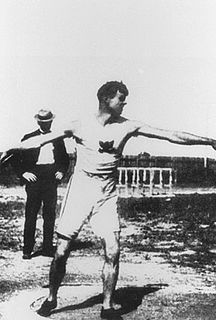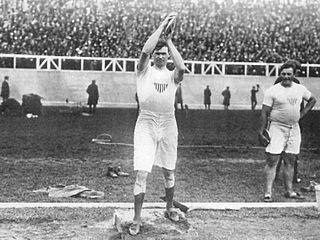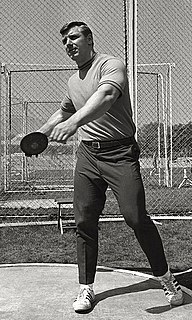 W
WThe discus throw is one of four track and field throwing events held at the Summer Olympics. The men's discus throw has been present on the Olympic athletics programme since 1896. The women's event was first contested at the 1928 Olympics, being one of the five athletics events in the inaugural Olympic women's programme.
 W
WThe men's discus throw event at the 2020 Summer Olympics is scheduled to take place between 30 and 31 July 2021 at the Japan National Stadium. Approximately 35 athletes are expected to compete; the exact number will depend on how many nations use universality places to enter athletes in addition to the 32 qualifying through distance or ranking.
 W
WThe men's discus throw was one of two throwing events on the Athletics at the 1896 Summer Olympics programme. The discus throw was the fourth event held. It was contested on 6 April. 9 athletes competed, including one each from France, Sweden, the United States, and Great Britain as well as three Greeks and two Danes.
 W
WThe men's discus throw was a track & field athletics event at the 1900 Summer Olympics in Paris. It was held on July 14 and July 15, 1900. 17 discus throwers from nine nations competed. The event was won by Rudolf Bauer of Hungary, the nation's first victory in the men's discus throw. František Janda-Suk gave Bohemia its first medal in the event, also in that nation's first appearance. Richard Sheldon's bronze put the United States in the top three for the second consecutive Games.
 W
WThe men's discus throw was a track and field athletics event held as part of the Athletics at the 1904 Summer Olympics programme. It was the third time the event was held. The competition was held on Saturday, September 3, 1904. Six athletes from two nations competed.
 W
WThe men's discus throw was one of six throwing events on the Athletics at the 1908 Summer Olympics programme in London. The competition was held on July 16, 1908. 42 throwers from eleven nations competed. NOCs could enter up to 12 athletes. The event was won by Martin Sheridan of the United States, his second consecutive victory in the event. The Americans completed their first sweep in the discus throw, with Merritt Giffin taking silver and Bill Horr bronze.
 W
WThe men's Greek-style discus throw was one of six throwing events on the Athletics at the 1908 Summer Olympics programme in London. The competition was held on 18 July 1908. In the Greek-style event, throwers hurled the discus from atop a rectangular platform raised above the ground. Throwing style was strictly prescribed by the rules of the event. The event had been contested at the 1906 Summer Olympics, but was not held again after 1908. NOCs could enter up to 12 athletes.
 W
WThe men's discus throw was a track and field athletics event held as part of the athletics at the 1912 Summer Olympics programme. The competition was held on Friday, July 12, 1912. Forty-one discus throwers from 15 nation competed. NOCs could enter up to 12 athletes. The event was won by Armas Taipale of Finland, the nation's first medal in the men's discus throw. Richard Byrd took silver and James Duncan took bronze to continue the United States' podium streak at five consecutive Games.
 W
WThe men's two handed discus throw was a track and field athletics event held as part of the Athletics at the 1912 Summer Olympics programme. It was the only appearance of the event at the Olympics, along with the other two handed throws. The format of the event was such that each thrower threw the discus three times with his right hand and three times with his left hand. The best distance with each hand was summed to give a total. The three finalists received three more throws with each hand. The competition was held on Saturday, July 13, 1912. Twenty discus throwers from six nations competed. NOCs could enter up to 12 athletes.
 W
WThe men's discus throw event was part of the track and field athletics programme at the 1920 Summer Olympics. The competition was held on Saturday, August 21, 1920, and on Sunday, August 22, 1920. 17 discus throwers from eight nations competed. No nation had more than 4 athletes, suggesting the limit had been reduced from the 12 maximum in force in 1908 and 1912. The event was won by Elmer Niklander of Finland, the nation's second consecutive victory in the men's discus throw. Armas Taipale, the winner in 1912, took silver to become the second man to win multiple medals in the event. Gus Pope took bronze, continuing the American streak of podium appearances at all six discus competitions to date.
 W
WThe men's discus throw event was part of the track and field athletics programme at the 1924 Summer Olympics. The competition was held on Sunday, July 13, 1924. 32 discus throwers from 18 nations competed. The maximum number of athletes per nation was 4. The event was won by Bud Houser of the United States, the nation's fourth victory in the men's discus throw ; the Americans had medalled in each of the Olympic discus throw events to date. Houser had also won the shot put. Vilho Niittymaa took silver, keeping Finland on the podium in the event for the third straight Games. Thomas Lieb gave the United States its second discus throw medal of 1924, with his bronze.
 W
WThe men's discus throw event was part of the track and field athletics programme at the 1928 Summer Olympics. The competition was held on Wednesday, August 1, 1928. Thirty-four discus throwers from 19 nations competed. The maximum number of athletes per nation was 4. The event was won by Bud Houser, the second man to successfully defend Olympic gold in the discus throw. It was the fifth American victory in the event. As in 1924, silver went to Finland and bronze to the United States.
 W
WThe women's discus throw event was part of the track and field athletics programme at the 1928 Summer Olympics. It was the first medal decision of a women's event in Olympic athletics. The competition was held on Tuesday, July 31, 1928. Twenty-one discus throwers from twelve nations competed.
 W
WThe men's discus throw event at the 1932 Olympic Games took place August 3. Eighteen athletes from 11 nations competed. The 1930 Olympic Congress in Berlin had reduced the limit from 4 athletes per NOC to 3 athletes. The event was won by John Anderson of the United States, the nation's third consecutive and sixth overall victory in the men's discus throw. Henri LaBorde took silver, marking the first time since 1908 that the same nation had the top two discus throwers. Paul Winter was the bronze medalist, earning France's first discus medal. Finland's four-Games podium streak ended, while the United States extended its streak to all nine appearances of the event.
 W
WThe men's discus throw event was part of the track and field athletics programme at the 1936 Summer Olympics. The competition was held on August 5, 1936. Thirty-one athletes from 17 nations competed. The maximum number of athletes per nation had been set at 3 since the 1930 Olympic Congress. The final was won by Ken Carpenter of the United States. It was the nation's fourth consecutive, and seventh overall, victory in the men's discus throw; it was also the second consecutive Games that the Americans finished with both of the top two places, as Gordon Dunn took silver. Giorgio Oberweger earned Italy's first men's discus throw medal with his bronze.
 W
WThe men's discus throw event was part of the track and field athletics programme at the 1948 Summer Olympics. Twenty-eight athletes from 18 nations competed. The maximum number of athletes per nation had been set at 3 since the 1930 Olympic Congress. The competition was held on August 2. The final was won by Adolfo Consolini of Italy. It was the nation's first victory in the men's discus throw; Italy had previously taken bronze in 1936. Giuseppe Tosi earned silver to put Italy in the top two places. Fortune Gordien of the United States won bronze, keeping the Americans on the podium in each appearance of the men's discus throw to date.
 W
WThe men's discus throw was an event at the 1956 Summer Olympics in Melbourne, Australia. Twenty athletes from 15 nations competed. The maximum number of athletes per nation had been set at 3 since the 1930 Olympic Congress. The qualifying round and the final both were held on Tuesday November 27, 1956. The event was won by Al Oerter of the United States, the nation's second consecutive and ninth overall victory in the men's discus throw. It was the first of four straight gold medals for Oerter. The United States earned its second medal sweep in the event, as Fortune Gordien took silver and Des Koch took bronze. Gordien became the fifth man to win two medals in the event, and the first to do so in non-consecutive Games. Italy's three-Games medal streak in the event ended.
 W
WThe men's discus throw throwing event at the 1960 Summer Olympics took place on September 6 & September 7. Thirty-five athletes from 22 nations competed. The maximum number of athletes per nation had been set at 3 since the 1930 Olympic Congress. The event was won by Al Oerter of the United States, the nation's third consecutive and 10th overall victory in the men's discus throw. It was Oerter's second gold medal in the event; he would go on to win four. Oerter was the sixth man to win two medals in the event, and the third to win two gold medals. The United States earned its second consecutive and third overall medal sweep in the event, as Rink Babka took silver and Dick Cochran bronze.
 W
WThe men's discus throw was one of four men's throwing events on the Athletics at the 1964 Summer Olympics program in Tokyo. It was held on 15 October 1964. 29 athletes from 21 nations entered, with 1 additional athlete not starting in the qualification round. The maximum number of athletes per nation had been set at 3 since the 1930 Olympic Congress. The event was won by Al Oerter of the United States, the nation's fourth consecutive and 11th overall victory in the men's discus throw. Oerter became the first man to win three medals in the event, all of them gold. He was only the second person to win three consecutive gold medals in any individual athletics event. It was the third of his four consecutive wins in the event. Ludvik Danek of Czechoslovakia took silver to break up the Americans' two-Games dominance of the discus podium; no non-American had won a medal since 1952. Dave Weill earned bronze to make this the fourth straight Games that the United States had won at least two medals in the event.
 W
WThe men's discus throw competition at the 1968 Summer Olympics in Mexico City, Mexico took place on October 14–15. Twenty-seven athletes from 19 nations competed. The maximum number of athletes per nation had been set at 3 since the 1930 Olympic Congress. The event was won by Al Oerter of the United States, the nation's fifth consecutive and 12th overall victory in the men's discus throw. Oerter finished his run of four victories in the event, the first person to win four consecutive gold medals in any individual Olympic event. For the first time during Oerter's reign, he was the only American on the podium as Lothar Milde of East Germany and Ludvík Daněk of Czechoslovakia took the other two medals. Daněk was the seventh man to win at least two discus throw medals; Oerter remains the only one to win four.
 W
WThe men's discus throw field event at the 1972 Olympic Games took place on September 1 and 2. Twenty-nine athletes from 18 nations competed. The maximum number of athletes per nation had been set at 3 since the 1930 Olympic Congress. After the retirement of four-time Olympic champion Al Oerter, this was an event that was open to everyone. The favorite was two-time Olympic medalist and 1971 European Champion Ludvík Daněk. Daněk won, completing a full set of three different medals in the event; it was Czechoslovakia's first gold medal in the men's discus throw. Daněk was the second man to win three medals in the event. Jay Silvester of the United States took silver, keeping alive the American streak of medaling in every appearance of the event. Ricky Bruch earned Sweden's first medal in the men's discus throw with his bronze.
 W
WThe men's discus throw event at the 1976 Summer Olympics in Montreal, Quebec, Canada had an entry list of 30 competitors from 20 nations, with two qualifying groups before the final (15) took place on Sunday July 25, 1976. The maximum number of athletes per nation had been set at 3 since the 1930 Olympic Congress. The top twelve and ties, and all those reaching 60.00 metres advanced to the final. The qualification round was held in Saturday July 24, 1976. The event was won by Mac Wilkins of the United States, the nation's 13th victory in the men's discus throw. Wolfgang Schmidt took silver, matching East Germany's best result to date in the event. John Powell gave the United States a second medal in the competition with his bronze. Czechoslovakia's three-Games medal streak, all won by Ludvík Daněk, ended as Daněk finished ninth; the American streak reached 18 Games.
 W
WThe men's discus throw competition at the 2004 Summer Olympics in Athens was held at the Olympic Stadium on 21–23 August. It was originally planned to hold the discus throw at the Ancient Olympia Stadium, but it was discovered that the field was not large enough to accommodate the range of modern discus throwers, and would have posed a danger to spectators. As such, it was decided to move the discus throw and to hold the shot put at the ancient stadium, despite the fact that the shot put was not contested at the Ancient Olympic Games. Thirty-name athletes from 26 nations competed.
 W
WThe men's discus throw event at the 2008 Summer Olympics took place on 16–19 August at the Beijing National Stadium. Thirty-seven athletes from 29 nations competed. The event was won by Gerd Kanter of Estonia, the nation's first victory in the men's discus throw. Piotr Małachowski took silver to give Poland its first medal in the event. Lithuanian thrower Virgilijus Alekna's bronze made him the third man to win three medals in the sport, adding to his gold medals from 2000 and 2004.
 W
WThe men's discus throw was a competition at the 2012 Summer Olympics in London, United Kingdom. The event was held at the Olympic Stadium on 6–7 August. Forty-one athletes from 24 nations competed. The event was won by Robert Harting of Germany, the nation's first victory in the men's discus throw since 1996 and second overall. Ehsan Haddadi earned Iran's first medal in the event with his silver. Gerd Kanter of Estonia became the 15th man to win multiple medals in the event, adding a bronze to his 2008 gold. Virgilijus Alekna of Lithuania narrowly missed being the second man to win four medals in the event, finishing fourth.
 W
WThe women's discus throw competition at the 2012 Summer Olympics in London, United Kingdom was held at the Olympic Stadium on 3–4 August. Each athlete received three throws in the qualifying round. All who achieved the qualifying distance progressed to the final. If less than twelve athletes were to achieve this mark, then the twelve furthest throwing athletes would reach the final. Each finalist is allowed three throws in last round, with the top eight athletes after that point being given three further attempts.